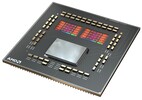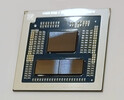AMD Ryzen 7 5700X vs AMD Ryzen 9 7940HX vs AMD Ryzen 9 7945HX3D
AMD Ryzen 7 5700X
► remove from comparison
The AMD Ryzen 7 5700X is a desktop processor with 8 cores and simultaneous multithreading (SMT), which means it can process 16 threads simultaneously. In April 2022, AMD presented the Ryzen 7 5700X, a new 8-core processor that is very similar to the AMD Ryzen 7 5800X. However, due to the lower TDP, there are no restrictions on the clock frequency. Nevertheless, the AMD Ryzen 7 5700X reaches up to 4.6 GHz in boost, which is only 100 MHz less than the AMD Ryzen 7 5800X. However, the base clock drops significantly to 3.4 GHz.
The performance of the AMD Ryzen 7 5700X is consistently excellent in all applications. The native 8-core can really show off its strengths, especially in multi-threaded applications, although the single-core performance has also been significantly improved compared to the older Zen 2 architecture.
The internal structure of the processor is similar to the AMD Ryzen 7 5800X. The CCX modules are also connected to each other via the I/O die, which we already know from Zen2. However, according to AMD, the Infinity Fabric should now achieve clock rates of up to 2 GHz, which in turn enables a RAM clock rate of 4,000 MHz without any loss of performance.
In terms of manufacturing processes, AMD also relies on TSCM for the 7nm production of the CPU cores in the Vermeer processors, although the I/O die is still supplied in 12 nm by Globalfoundries.
The AMD Ryzen 7 5700X is impressive in gaming thanks to the significantly improved IPC compared to Zen2. In terms of power consumption, the AMD Ryzen 7 5700X impresses with its low TDP of just 65 watts. This means that the processor can also be operated with a compact air cooler without any problems. The AMD Ryzen 7 5800X is operated with a TDP of 105 watts.
AMD Ryzen 9 7940HX
► remove from comparison
The AMD Ryzen 9 7940HX is a high-end notebook processor from the Dragon Range series with 16 cores and hyperthreading (SMT), which means it can process up to 32 threads simultaneously. The CPU uses the current Zen 4 architecture for the 16 cores and clocks these from 2.4 GHz (base clock) up to 5.2 GHz (single-core boost). The CPU offers 16 MB L2 cache and 64 MB L3 cache (i.e. a total of 80 MB cache). The 7940HX consists of three chiplets, two CCD clusters with 8 CPU cores each made with a 5nm node (71mm²) and one IO die on 6nm (122mm²), are all manufactured at TSMC's fabs.
The performance of the Ryzen 9 should be comparable to a Core i9-13900HX (24 hybrid cores, max 5.4 GHz) in the top range of mobile processors from 2024. AMD itself advertises a clear lead over the old Ryzen 9 6900HX (8 Zen 3 cores, 4.9 GHz), which can be explained by the additional cores, improved architecture and higher frequencies. Compared to the top model, the Ryzen 9 7945HX, the 7940HX is slightly lower clocked.
The chip also integrates 4x USB 3.2 Gen2 (10 Gbps) ports (no USB 4), 28 PCIe 5.0 lanes (for GPUs and SSDs), a dual-channel DDR5-5200 memory controller and a small AMD Radeon 610M graphics card (2CUs, 400 - 2200 MHz).
The R9 7940HX is specified with 55 watts TDP and can be configured up to 75 watts (cTDP).
AMD Ryzen 9 7945HX3D
► remove from comparison
The AMD Ryzen 9 7945HX3D is a fast high-end laptop processor of the Dragon Range series. It offers 16 cores based on the Zen 4 architecture that supports hyperthreading (32 threads). The cores clock from 2.3 (base) up to 5.4 GHz (single core boost). Compared to the similar R9 7945HX, the 7945HX3D offers an additional 64 MB 3D V-Cache on one CCD-Cluster. This helps in some workloads that can use the additional fast cache (e.g. some games). The guaranteed base clock however was reduced from 2.5 to 2.3 GHz.
The performance of the R9 7945HX3D is similar to the R9 7945HX in workloads that wont make use of the bigger L3 cache. Most games however can use the additional memory. AMD e.g. was advertising the HX3D with 4% to 53% higher performance in 1080p high settings.
The Dragon Range series still uses a chiplet design with two CCD-clusters (each with 8 possible cores) in 5nm and an IO-die (including the memory controller and the Radeon 610M iGPU) in 6nm. The chip integrates 4x USB 3.2 Gen2 (10 Gbps) ports (no USB4), 28 PCIe 5.0 lanes (for GPU and SSDs) and a dual-channel DDR5-5200 memory controller.
The R9 7945HX3D is rated at a TDP of 55 Watt and can be configured up to 75 Watt (cTDP).
| Model | AMD Ryzen 7 5700X | AMD Ryzen 9 7940HX | AMD Ryzen 9 7945HX3D | ||||||||||||||||||||||||||||||||||||||||||||||||||||||||
| Codename | Vermeer (Zen 3) | Dragon Range-HX (Zen 4) | Dragon Range-HX (Zen 4) | ||||||||||||||||||||||||||||||||||||||||||||||||||||||||
| Series | AMD Vermeer (Ryzen 5000) | AMD Dragon Range (Zen 4, Ryzen 7X4X/8X4X) | AMD Dragon Range (Zen 4, Ryzen 7X4X/8X4X) | ||||||||||||||||||||||||||||||||||||||||||||||||||||||||
| Series: Dragon Range (Zen 4, Ryzen 7X4X/8X4X) Dragon Range-HX (Zen 4) |
|
|
| ||||||||||||||||||||||||||||||||||||||||||||||||||||||||
| Clock | 3400 - 4600 MHz | 2400 - 5200 MHz | 2300 - 5400 MHz | ||||||||||||||||||||||||||||||||||||||||||||||||||||||||
| L1 Cache | 512 KB | 1 MB | 1 MB | ||||||||||||||||||||||||||||||||||||||||||||||||||||||||
| L2 Cache | 4 MB | 16 MB | 16 MB | ||||||||||||||||||||||||||||||||||||||||||||||||||||||||
| L3 Cache | 32 MB | 64 MB | 128 MB | ||||||||||||||||||||||||||||||||||||||||||||||||||||||||
| Cores / Threads | 8 / 16 | 16 / 32 16 x 5.2 GHz AMD Zen 4 | 16 / 32 16 x 5.4 GHz AMD Zen 4 | ||||||||||||||||||||||||||||||||||||||||||||||||||||||||
| TDP | 65 Watt | 55 Watt | 55 Watt | ||||||||||||||||||||||||||||||||||||||||||||||||||||||||
| Technology | 7 nm | 5 nm | 5 nm | ||||||||||||||||||||||||||||||||||||||||||||||||||||||||
| Die Size | 2 x 74 sq. mm; I/O = 125 sq. mm mm2 | ||||||||||||||||||||||||||||||||||||||||||||||||||||||||||
| max. Temp. | 90 °C | 100 °C | 89 °C | ||||||||||||||||||||||||||||||||||||||||||||||||||||||||
| Socket | 1331 | FL1 | FL1 | ||||||||||||||||||||||||||||||||||||||||||||||||||||||||
| Features | MMX(+), SSE, SSE2, SSE3, SSSE3, SSE4.1, SSE4.2, SSE4A, x86-64, AMD-V, AES, AVX, AVX2, FMA3, SHA, Precision Boost 2 | DDR5-5200 RAM, PCIe 5, MMX, SSE, SSE2, SSE3, SSSE3, SSE4A, SSE4.1, SSE4.2, AVX, AVX2, AVX-512, BMI2, ABM, FMA, ADX, SMEP, SMAP, SMT, CPB, AES-NI, RDRAND, RDSEED, SHA, SME | |||||||||||||||||||||||||||||||||||||||||||||||||||||||||
| Architecture | x86 | x86 | x86 | ||||||||||||||||||||||||||||||||||||||||||||||||||||||||
| $299 U.S. | |||||||||||||||||||||||||||||||||||||||||||||||||||||||||||
| Announced | |||||||||||||||||||||||||||||||||||||||||||||||||||||||||||
| Manufacturer | www.amd.com | www.amd.com | www.amd.com | ||||||||||||||||||||||||||||||||||||||||||||||||||||||||
| Transistors | 9900 Million | ||||||||||||||||||||||||||||||||||||||||||||||||||||||||||
| iGPU | AMD Radeon 610M (400 - 2200 MHz) | AMD Radeon 610M (400 - 2200 MHz) |
Benchmarks
Average Benchmarks AMD Ryzen 7 5700X → 100% n=7
Average Benchmarks AMD Ryzen 9 7940HX → 156% n=7
Average Benchmarks AMD Ryzen 9 7945HX3D → 171% n=7
* Smaller numbers mean a higher performance
1 This benchmark is not used for the average calculation













